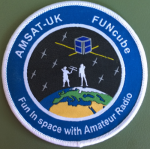
12-year-old Matteo Micheletti from Belgium received a special mention from ESA for receiving the OUFTI-1 CubeSat
On April 21, 2016, ESA’s Education Office set a challenge for the worldwide radio amateur community to start listening out for three new orbiting CubeSats. The results have now been released.
ESA’s Education Office published the transmission frequencies of the student-built satellites that were about to be launched as part of the Fly Your Satellite! Programme, and invited the radio amateur community to listen out for them.
The first three radio amateurs to send a recorded signal from AAUSAT4, e-st@r-II or OUFTI-1 would receive a prize from ESA’s Education Office. Hundreds of radio amateurs from around the world joined in the friendly competition.
The CubeSats started sending signals after their release from the Soyuz VS-14 rocket and the triggering of their automatic activation sequence. Participants from Russia, USA, Poland, France, Belgium, Netherlands, Brazil, Italy, Denmark, and more tuned their receivers and listened.
Thanks to skill and patience on the ground, the winners come from Russia, the United States of America, Germany, and the Netherlands.
Contact with the first CubeSat came at 00:53:51 UT on April 26, 2016, within an hour of its separation from the launcher. Dmitri Paschkow R4UAB, Russia, heard the signal from OUFTI-1 using two receiving stations, in Kemerovo and Ruzaevka. Upon hearing OUFTI-1, he communicated the news immediately. “I understand that the students are worried [to hear from their satellite] and decided to please them!” says Paschkow.
Just over an hour after the first signal from OUFTI-1 was recorded, the next CubeSat checked in.
AAUSAT-4 was heard over California, US, by Justin Foley KI6EPH of California Polytechnic State University. He had a personal interest in the mission because some of his colleagues had developed the P-POD deployer that was used to eject the CubeSats into orbit.
He was ready at the receiver from the moment of deployment but heard nothing on that first pass, probably because the activation sequence had not yet completed. The signal came through on the second pass, arriving at 02:02 UT.
“It was extremely exciting to see signals from the newly launched satellite, and witness the beginning of a space mission”, says Foley.
Then the wait began for e-st@r-II. At 05:40:58 UT, something dimly lit the screen of Mike Rupprecht DK3WN in Germany. But something was not quite right. It certainly looked like a signal from the last remaining CubeSat, but why was the message so faint? It galvanized the amateur radio community to look harder.
Jan van Gils PE0SAT had to wait until May 2 at 16:38:05 UT to receive a signal from e-st@r-II that was strong enough to be decoded. Why e-st@r-II was only transmitting weak signals is under investigation, but the most important news is that all three CubeSats are functioning and transmitting, and their signals can be decoded.
A special mention goes to a young radio amateur who scored a personal best. Twelve year-old space enthusiast Matteo Micheletti from Belgium caught the OUFTI-1 signal with a portable log periodic antenna and a portable receiver. His triumph occurred on May 1, 2016 between 17:34 and 17:39 UT.
To mark their success, the radio amateur winners will each receive a Fly Your Satellite! Poster, a goodie bag and a scale 1:1 3D printed model of a CubeSat from ESA’s Education Office.
Read the full ESA story at http://www.esa.int/Education/CubeSats_-_Fly_Your_Satellite/CubeSats_competition_winners
Three new CubeSats now in orbit https://amsat-uk.org/2016/04/26/three-new-cubesats-now-in-orbit/
D-STAR satellite to launch from Kourou https://amsat-uk.org/2016/04/05/d-star-satellite-to-launch-from-kourou/










You must be logged in to post a comment.